So, you’ve planted your almond tree following our handy guide packed full of growing recommendations, thanks to which you now have a beautiful and bountiful crop.
Now the question is, how and when is best to harvest your almonds to make the most of them?
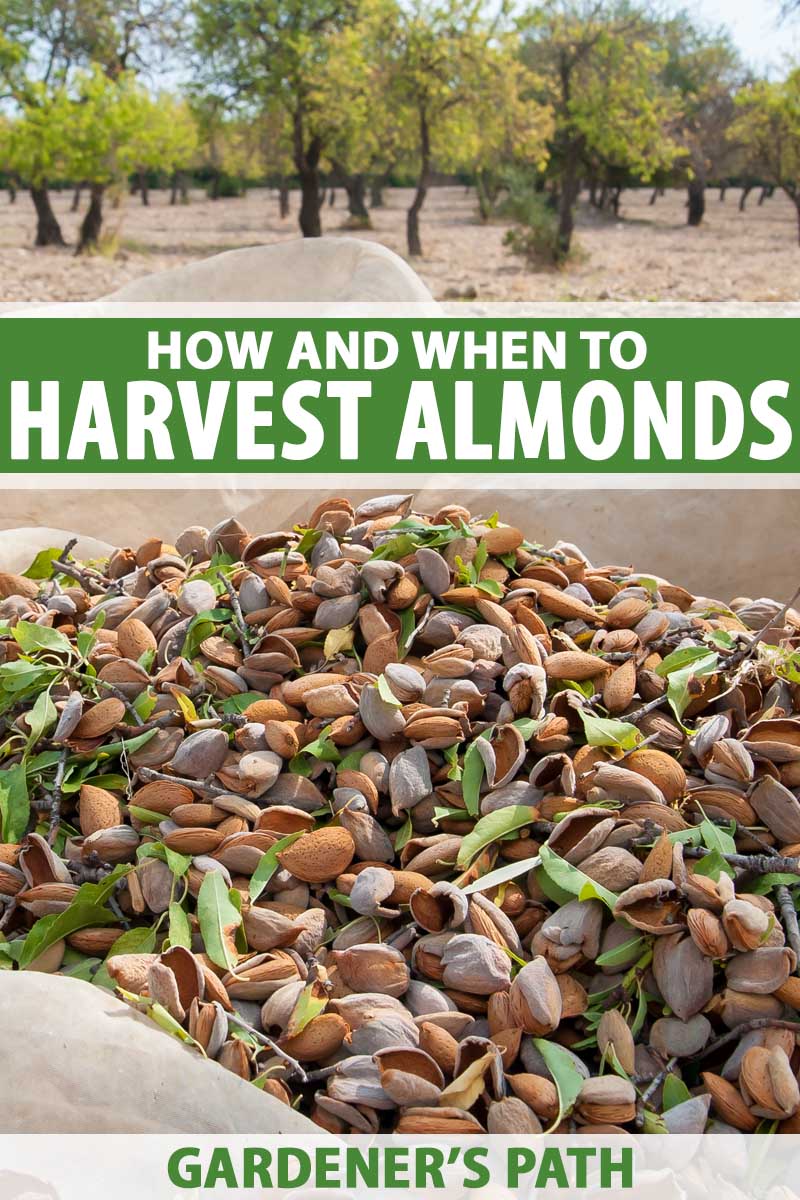
We link to vendors to help you find relevant products. If you buy from one of our links, we may earn a commission.
Well, the way that you harvest, process, and store your nuts can have a huge effect on the quality and quantity that you are able to enjoy from your tree, so it’s important to know the best techniques.
What You’ll Learn
Don’t be Duped by Your Drupes
You might know that peanuts aren’t nuts, but it might come as a surprise to you (as it did to me when I found this out!) that almond trees don’t actually produce nuts. Instead, they produce something called drupes.
A drupe is a type of fruit that has an outer fleshy part around a shell, which in turn protects the seed inside. Peaches, plums, and cherries are all typically well-known drupes, but somewhat more surprisingly, so are walnuts, almonds, and pecans – they’re just drupes from which we eat the seed inside the pit instead of the fruit!
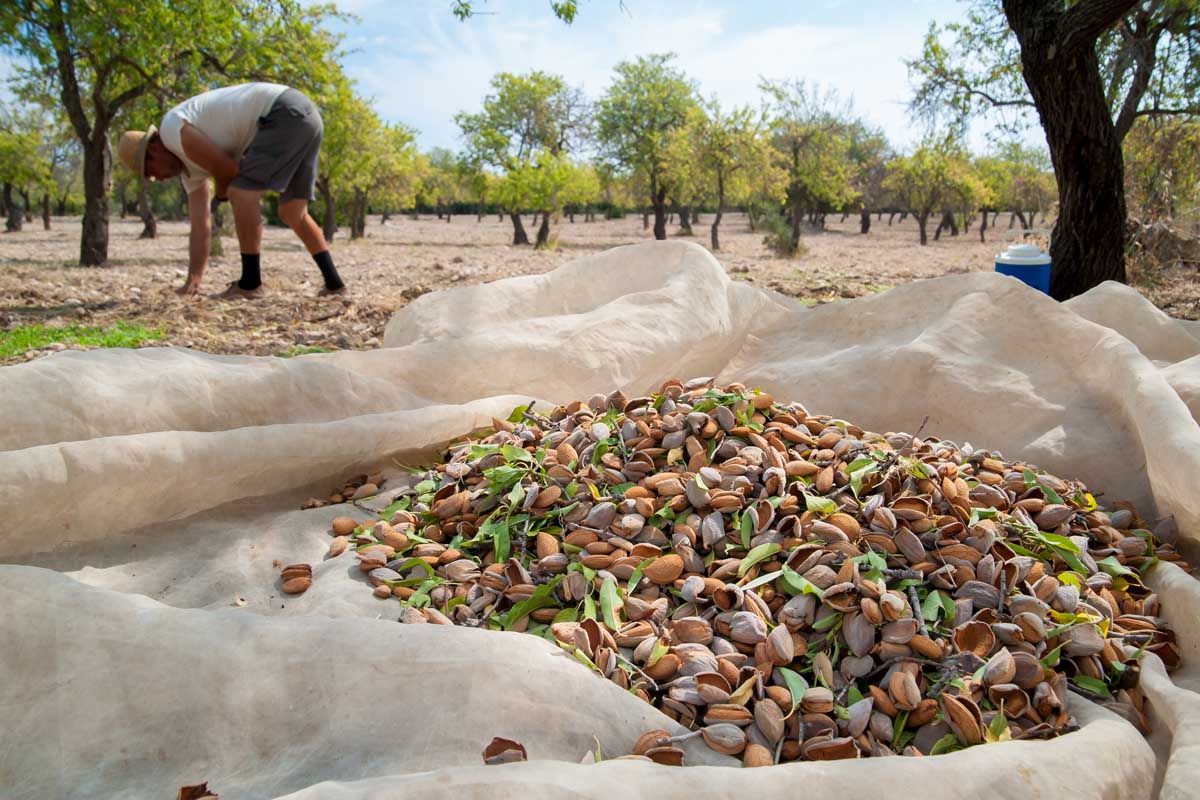
Drupes grow from the tree’s fertilized flowers and mature in autumn. Almond drupes have a green, leathery hull that surrounds them.
To help your drupes along, it’s best to give your almonds a healthy watering just before harvest, as this encourages the drupes to split.
Signs of Splitting? It’s Time to Get Picking
If you want to know when to pick your almonds, you just need to observe your drupes. When the outer husk dries and splits, and the drupes start to fall from the tree, it’s time to start thinking about picking almond nuts.
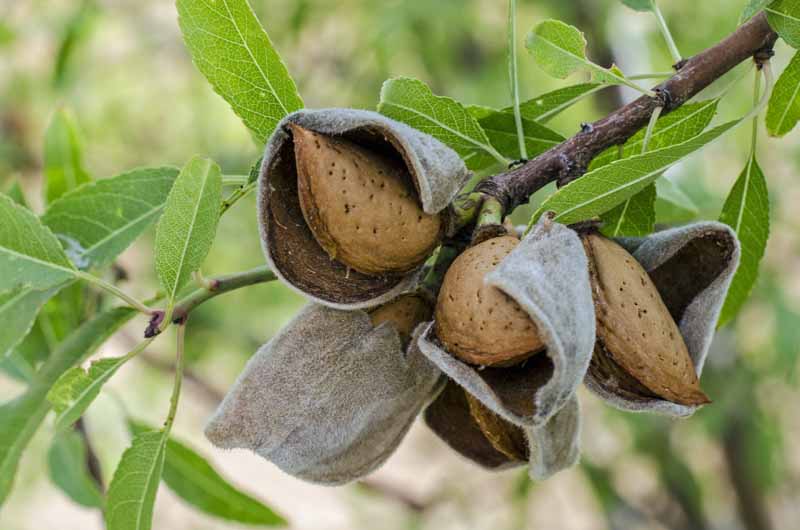
A safe bet is to start picking when you see that most (around the 75% mark) of your drupes have started to split. This usually happens during August or September, depending on the variety of almond.
But, beware – don’t be duped by your drupes! A top tip is to make sure you don’t just check your trees at eye-level. Because almonds ripen from the top of the tree down, by the time you see that they are ready, you may well be too late.
Although you technically don’t have to harvest immediately, your nuts will spoil if they get wet, so it’s best to pick them before any risk of rain. Also, almonds provide an irresistible treat for hungry squirrels and some birds, so you’ll want to get there before they do!
Regardless of this, it’s generally preferable to harvest them when you see that they are ready, as it has been shown that a late harvest reduces crop volume, nut quality, and also shortens their shelf life. The best option is to harvest what’s ripe as soon as you see signs of splitting.
How to Harvest Your Haul
Thanks to their protective shells, harvesting almonds is easy. All you have to do is knock or shake them from the tree and let them fall to the ground, where you can put a tarp or groundsheet in place for ease of collection.

Commercial farmers often have machines made just for shaking the nuts to the ground. But for backyard harvests, all you really need is a big stick to bang the branches with.
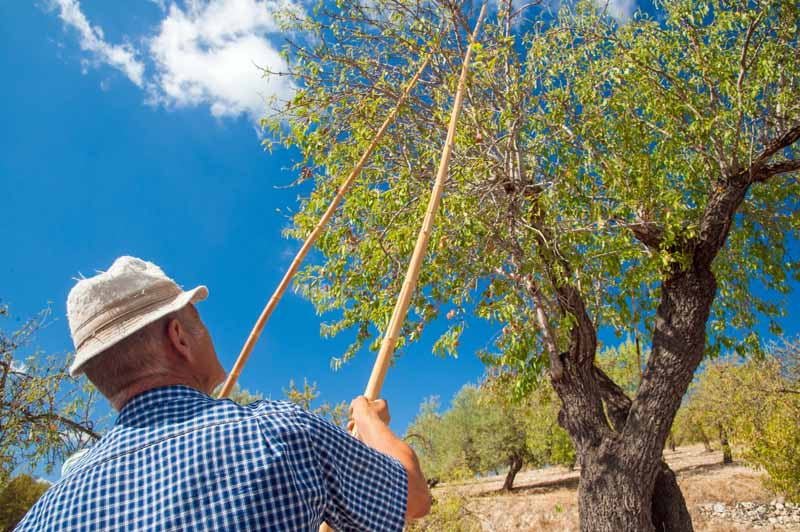
This works really well on small branches. It’s best to find a wooden, fiberglass, or plastic pole.
For the larger branches it might be a bit trickier, in which case you can tap them with a rubber mallet.
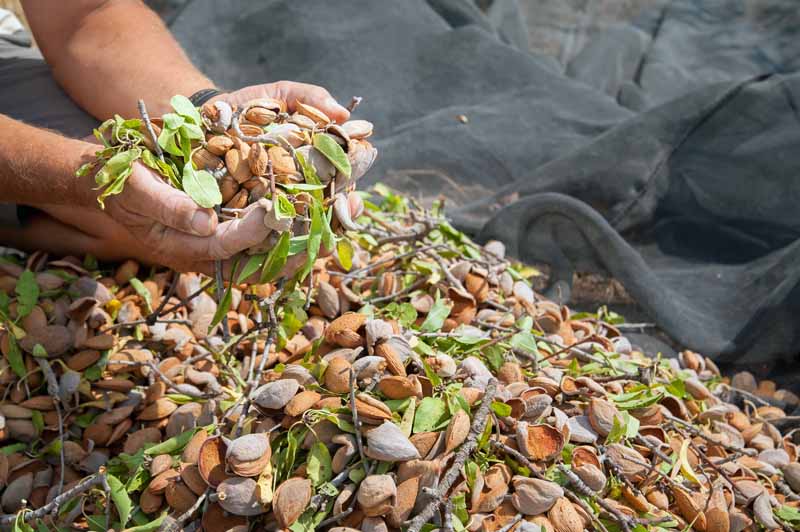
Obviously, watch out for falling nuts overhead. This can be a bit of a hazard, but one that is easily solved by wearing a hard hat or glasses to protect your eyes (always better safe than sorry!).

Hulling and Drying
Straight away after harvesting, the hulls around the nuts need to be removed. For small quantities, this is best done by hand. This process can be a bit long, but it is still the most efficient way for non-commercial growers to process their crops.
Even nuts that are harvested at the correct time need to be dried out a bit more in order to prevent rotting and mold growth in storage.
Luckily, it’s easy to dry the nuts. All you need to do is spread them out thinly on a tray or a screen somewhere with good air circulation.
If this is somewhere outside, you might have to add a sheet over the top of them to make sure they’re safe from pesky pests or, most importantly, protected from the rain, which will ruin your harvest.
Every now and then, just have give a few almonds a quick check. If their kernels break, they’re dry enough and can be moved to storage. If they bend and are a bit rubbery, they need to be dried a bit longer.
Storage
Once your kernels are properly dried, it’s advisable to freeze them to kill off any pests that might be present, especially navel orange worms.
Before storing them, you then have a decision – to shell, or not to shell. Shelled almonds can last happily up to 8 months at room temperature, or out of their shells for around a year chilled at 32-45°F (0-7°C).
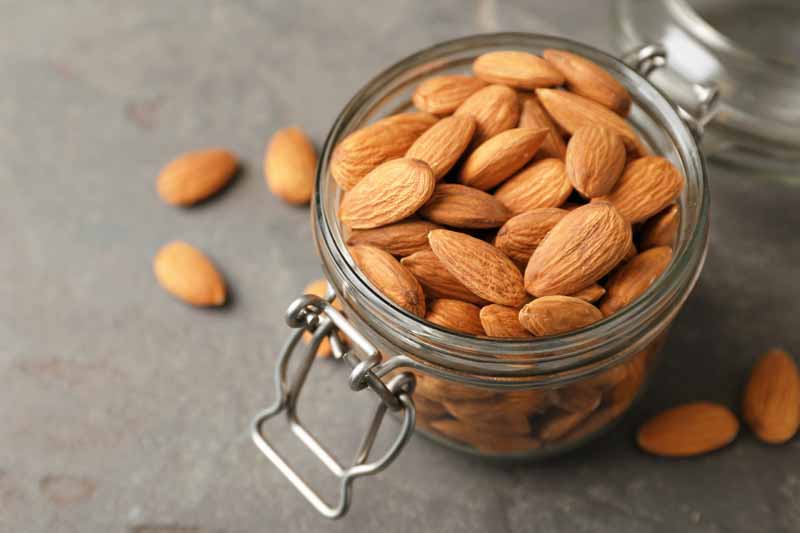
One thing to watch out for – the nuts will absorb any particularly pungent smells around them, so it’s best to avoid storing them near anything particularly fragrant like onions or garlic. Storage in airtight containers is preferable, to avoid any mishaps.
Any nuts that are dark in color, moldy, shriveled, that smell bitter or sour should be discarded, as occasionally the fats in the kernels can go bad.
In a Nutshell…
Although there are a few slightly technical things to know about harvesting and storage, gathering your own almonds is really a simple and easy process. Are you ready to get out there to start picking and preserving your crop? Tell us your stories and share your questions in the comments below.
And for more on tending to your own homegrown nut harvests, you’ll enjoy the following articles:
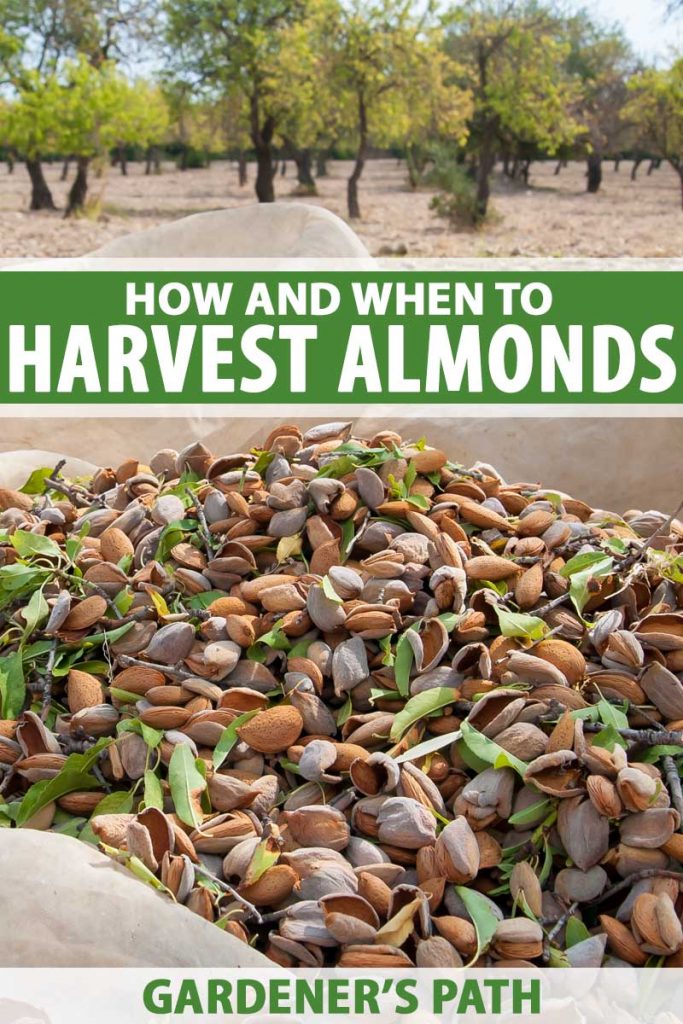
Can early harvested almonds be salvaged? The squirrels have dropped them, now in April, off the mature trees!
Can the be simply air dried, then peeled, stored. Do they have to be roasted, to be eaten? Thank you!
Hi Nanette, It sounds like what you have on your hands is something many people would love to have – green almonds! A friend brought me one of these once and it had a fascinating taste and texture. They can be eaten fresh or cooked. If they are very young, you can actually eat the outer fuzzy green hull, which is supposed to taste like an unripe peach – along with the immature almond inside, which is soft and gelatinous. If the hulls are a bit tougher, you’ll want to cut them open with a knife to get to the… Read more »
Alright! So I don’t quite understand the passage from removing the hull to drying the almond. Am I supposed to take the almonds out of their shell or not? And are softer almonds better for making almond milk? Thank you for making this post, I was so lost on what to do!
You’re welcome, Misha! Green almonds (picked when the hulls are still fresh and green) are great for making almond milk! I don’t know that this is necessarily better in any way, but it’s certainly an option. All nuts need to be soft to make milk out of them – they’re usually soaked for a period of hours before blending and straining, so I would imaging using fresh almonds for this could also cut down on the required soaking time. Removing the hulls is recommended if you plan to dry the almonds for long-term storage. If you leave the hulls on,… Read more »
What if your drupes never open enough and stay sticky?
Hi Carol – if the hull is sticky, causing them to not open even though they should be ready, then you’ll need to give them some help. If the hulls are ready to crack but they can’t open, the almond inside will rot.
Pull them off the tree and lay them out in an area with sunlight and good air circulation so they can dry out. They should open or you can crack them on your own once they dry.
Thank you. Helpful and nicely written.
Can you clarify this for me? You wrote: “To help your drupes along, it’s best to give your almonds a healthy watering just before irrigation, as this encourages the drupes to split.”
We usually irrigate the trees before there are any fruit, so how does watering first help to promote splitting?
Thanks for catching our mistake! This should say to irrigate well before harvest time, to encourage splitting. We will correct this line in the article.
If trees are water stressed, the hulls will not split readily.
Is there a caution regarding arsenic poisoning with unripe almonds?
Raw bitter almonds contain a potentially toxic glycoside known as amygdalin. The concern here is poisonous hydrogen cyanide, one of the compounds that forms when bitter almonds are broken down through digestion – not arsenic. Some research suggests that cooking or heat treating may help to reduce the cyanide content of bitter almonds, but consuming them is not recommended.
Sweet almonds, on the other hand, are safe to consume. The amygdalin content of sweet almonds is tiny enough to be deemed insignificant.